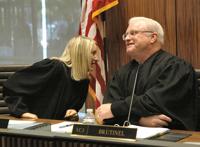PHOENIX — A prosecutor argued to the state Supreme Court that Arizonans never intended to legalize the use of marijuana extracts and edible products made from them when they voted to legalize marijuana for medical purposes in 2010.
The Arizona Medical Marijuana Act permits patients to have “usable marijuana,” Yavapai County prosecutor Benjamin Kreutzberg said.
That, he told the justices, means the flowers and leaves of the plant.
Anything else, including preparations made by extracting the resin — and the psychoactive THC — remains strictly illegal, he said.
To back his argument, Kreutzberg said the state criminal code long predates the medical marijuana law and has separate definitions for “marijuana,” meaning the plant, and “cannabis,” which covers things like hashish and other extracts.
But in legal arguments lasting about 45 minutes Tuesday, the justices didn’t seem to be buying his contention, though they gave no hint as to when they will rule.
Recently retired Justice John Pelander sat with the court because his replacement has not yet been appointed.
Pelander said the distinction between marijuana and cannabis was not evident in the materials given to voters in 2010. In fact, he said, the definition of marijuana in the voter-approved law includes “all parts” of the plant.
“It’s undisputed in this case that the resin that we’re talking about here is a part of the plant,” Pelander said. “So tell me again why the people of Arizona would have known that resin extracted from a marijuana plant would not be covered by AMMA?”
Officially the case is about the conviction of Rodney Jones for possession of 0.05 of an ounce of hashish despite the facts he has a state-issued card allowing him to have marijuana and he obtained the drug from a state-licensed dispensary. Prosecuted by the Yavapai County Attorney’s Office, he was sentenced to 2ƒ years in prison.
But the larger issue for the court is whether the network of dispensaries around Arizona will be able to continue to sell — and patients will be able to obtain — alternate forms of marijuana, such as candies, drinks and oils.
Attorney Robert Mandel, representing Jones, told the justices that the narrow interpretation being pushed by prosecutors makes no sense.
He said the whole purpose of the act was to enable patients with certain medical conditions to be able to access the chemicals in marijuana. And Mandel pointed out the law applies not only to adults but also to children.
“Nobody anticipated that 2-, 3-year-old minors were going to be rolling joints and smoking them, because that’s absurd,” he told the court.
Mandel said some of the medical conditions for which medical marijuana is approved include situations where people cannot smoke it or even eat it.
That led to a discussion of how to activate the ingredients in marijuana, the chemicals that are believed to help people with certain medical conditions.
Chief Justice Scott Bales acknowledged that reading the law the way Kreutzberg suggests — only allowing the use of the dried flowers — would mean that edibles made from extracts would be illegal.
“But it would be irrational because it would force people to use the least effective way of obtaining the therapeutic effects that are thought to be associated with cannabinoids,” Bales said. “It would mean you would have to eat a lot of well-baked brownies.”
That whole line of questioning about how to release the active chemicals led down the path to where Justice Ann Scott Timmer noted that one legal brief filed “went into some detail” on how marijuana brownies are made.
“Now I know exactly how to do that,” she quipped.
But the serious side of all that, said Timmer, is it appears heat is needed to make the drug medically effective, whether by burning the leaves, baking them in other products, or using a process to obtain the extract, which then can be placed into other products.
“It would not be possible, or at least have any medicinal qualities, if you will, if you simply ground up the dried buds and put them in the brownies because you wouldn’t reach the amount of heat ... to get to the appropriate property,” she said.
Timmer said there is no question in her mind that voters clearly intended that edible forms of marijuana be allowed for medical purposes.
“Crushed up flowers wouldn’t do anything for you,” she said.
“It can be done,” Kreutzberg replied.
“But is that likely?” Timmer responded, saying that presumes voters intended for children to have access only to the dried flowers.
Kreutzberg was unwilling to concede the point.
“I disagree that even if those processes might produce a drug that might be better in some sense, that means the people necessarily intended to adopt that formulation,” he said.
Timmer, however, suggested that the prosecution’s interpretation could lead to absurd results.
For example, she questioned what happens if a person has the flowers and rubs them in her hands, leaving an oily residue.
“Would the oily residue be prohibited?” Timmer asked.
“If something constitutes cannabis, and if something is no longer a mixture or preparation of the marijuana flowers, then, yes, it counts as cannabis,” and would be illegal under the Arizona Medical Marijuana Act, Kreutzberg said.
Bales also questioned Kreutzberg’s contention that the historical distinction in the criminal code between marijuana and cannabis somehow means that voters intended to limit the use of the drug solely to the leaves and flowers. He said the 2010 law spells out that what’s allowed also includes “preparations” of those parts of the plant.
“So it’s hard for me to see how you can attribute to the voters an intent to preserve a broad prohibition on cannabis and only permit a more narrow definition of marijuana when the AMMA itself has a broader definition,” Bales said.





